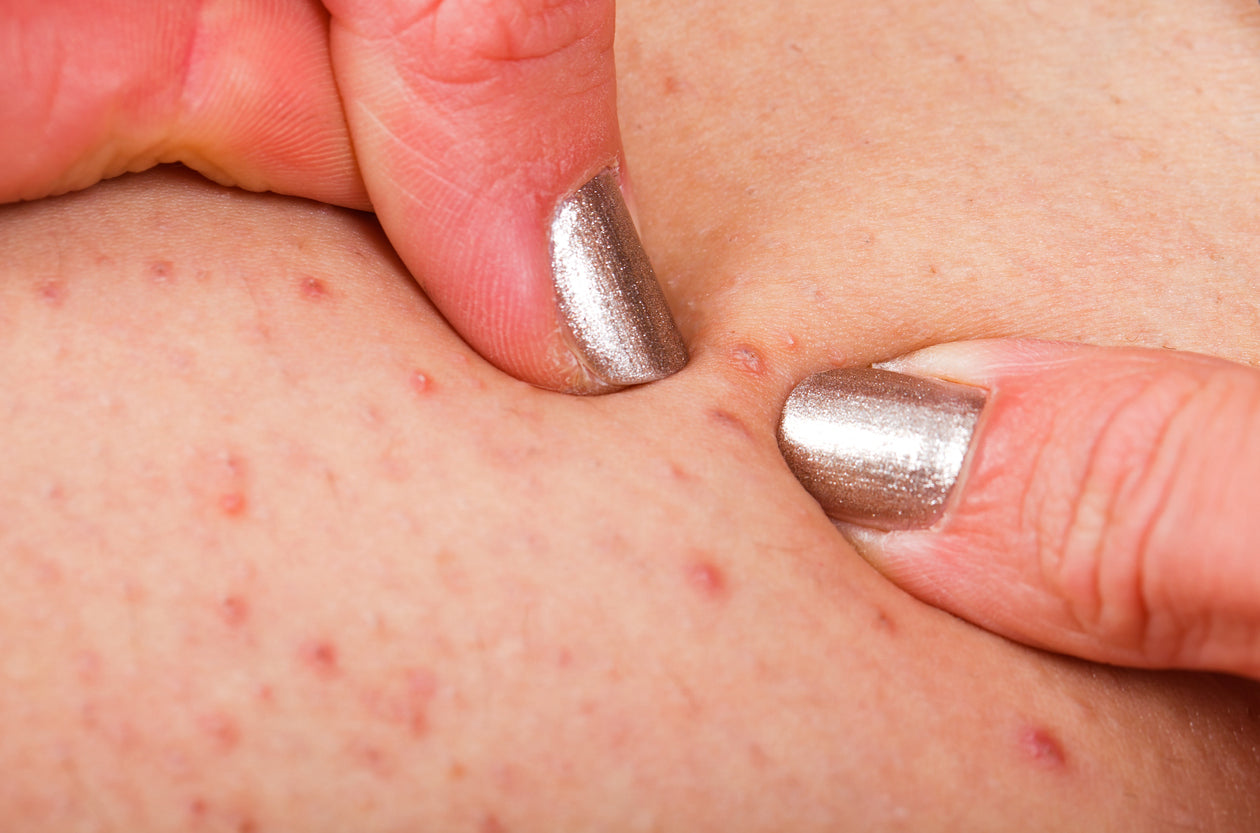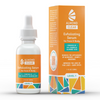About Folliculitis & Fungal Acne

Folliculitis (sometimes called "fungal acne") is a tricky skin condition. Many Almond Clear users were fooled by folliculitis for years, thinking that their red bumps were pimples and wondering why their blemishes weren’t clearing up with any of the usual acne treatment products. Even dermatologists often misdiagnose folliculitis as acne. So what is this tricky skin problem, and how can you actually get rid of it?
Folliculitis is a fungal or bacterial infection of the hair follicles. Acne, on the other hand, occurs in the pores and is primarily triggered by a buildup of dead skin cells and oil. You have hair follicles all over your body, so you can get folliculitis anywhere, but the most common places are the forehead, chest, butt, thighs, and anywhere where you tend to sweat. Men often suffer from folliculitis in the beard and scalp areas.
Folliculitis can be either fungal or bacterial, and in order to definitively know which microbe is causing your problem, you have to go to a dermatologist. However, only the fungal variety itches and burns, so if your breakouts are itchy then you're likely dealing with fungal acne.
Folliculitis usually looks like many small red bumps. Occasionally, a few of the bumps can flare up into full-on cysts or boils, but for the most part, the bumps tend to look pretty uniform. If you’re wondering what folliculitis looks like, check out this Google Image search.
Folliculitis Causes
A lot of things can cause folliculitis, and oftentimes, people have more than one contributing factor. Here’s a partial list of the causes that we know about (it’s still a pretty mysterious skin condition, so there’s a lot that we don’t understand yet):
- People who’ve taken multiple rounds of antibiotics are more likely to develop folliculitis. This is because antibiotics can throw the microbial balance of the skin out of whack, causing some microbes to proliferate well beyond their normal levels. The ironic thing is that dermatologists often prescribe antibiotics to treat acne, and as an unintended consequence, these antibiotics make people much more likely to develop folliculitis.
- If you have oily skin, then you’re more likely to get folliculitis. This is because the microbes that cause folliculitis feed off of sebum, the body’s natural oil. More oil equals more food for the microbes,so they’re able to spread even more. Also, if your pores and follicles are clogged with dead skin cells and oil, this creates an ideal oxygen-free, nutrient-rich environment for microbes to take hold and proliferate.
- If you live in a warm, humid environment, then you’re more likely to develop folliculitis. This is because the microbes reproduce best in warm and moist conditions. People who live in more seasonal climates find that their folliculitis improves when the air is colder and drier.
- If you sweat a lot, then this can aggravate your folliculitis. When sweat mixes with your body’s natural oil, it creates the perfect feast for folliculitis-causing microbes. This is why people who exercise a lot tend to get folliculitis in areas where sweat gets trapped against the skin, like under sports bras and tight-fitting shorts.

Folliculitis treatments
Here’s the good news: Chronic folliculitis can be fully controlled with the right skincare products and lifestyle changes. And acute folliculitis (acute skin infections that are transmitted in environments like hot tubs and lakes) can almost always be completely cured, especially if you see a doctor. So what’s the bad news? Well, if you suffer from chronic folliculitis, then it’s likely that it’ll reappear unless you continually keep it under control with skincare products and lifestyle modifications. This is nothing to fret about, though, because folliculitis management only requires a couple of easy additions to your self-care routine.
First, and most importantly, you need to regularly apply an antimicrobial product to your skin. Some people use a ketoconazole shampoo as a body wash and see good results. Ketoconazole is usually used to treat dandruff, but you can effectively use the shampoo as a body wash, just make sure to leave it on for several minutes before rinsing it off so that it has time to absorb into the skin a bit.
If you’re looking for a more natural treatment that’s actually intended for the skin, then consider Almond Clear. It’s powered by mandelic (almond) acid, which has naturally occurring antibacterial and antifungal properties. This means that Almond Clear can stop the microbes that cause both bacterial and fungal folliculitis! It’s also a strong exfoliant, meaning that it breaks the bonds between dead skin cells and oil so that follicles are unclogged and the material that’s feeding the microbes is dissolved.

Folliculitis lifestyle modifications
Skincare products alone can’t fully clear folliculitis. Your skin will also benefit from some adjustments to your lifestyle and personal care routine.
- After exercising or sweating, take a shower as soon as possible. Folliculitis loves warm, moist conditions, and the combination of sweat and oil contain all of the nutrients needed for the reproduction of folliculitis-causing microbes. It’s very important to shower right after sweating.
- If you can’t shower after exercising, then at least change out of your sweaty clothes and rinse your face. Then, it’s very helpful to apply a little Almond Clear to folliculitis-prone areas of skin. This will keep the microbes from spreading until you can shower up.
- Take an oral antifungal supplement. Good choices include caprylic acid, undecylenic acid, oil of oregano, garlic, olive leaf, and berberine. *make sure to consult your doctor before taking new any new supplement
- Avoid prolonged exposure to hot or warm water. This means minimizing your time in hot tubs, baths, and steam rooms. Yah, we know, this is kind of a bummer; we love a nice warm bath as much as the next person. You don’t have to eliminate steamy water from your life, just avoid it when you can.
- Reduce your intake of added sugar and processed foods, but don’t go all crazy on this! There are some people who develop eating disorders when they try to control their breakouts through dietary changes. Obviously, that’s replacing one problem with another one that’s equally as bad, if not worse. So be reasonable, meaning try to cut out the junky stuff in your diet whenever you can.

- If you have folliculitis on your body, then wear breathable clothing and underwear. Cotton and other natural fibers are good options. If you like wearing tight-fitting clothes during the day, then at least change into something loose and breathable when you’re home so that your skin has a chance to breathe.
- Replace your razor frequently, or purchase special razors for folliculitis-prone skin. If you’re an African American man or a person with very curly hair, then shave with a single blade razor. Bevel razors are a good option.
- Consider what other skincare products could be fueling your folliculitis breakouts. This website is an excellent resource for folliculitis-safe products.


